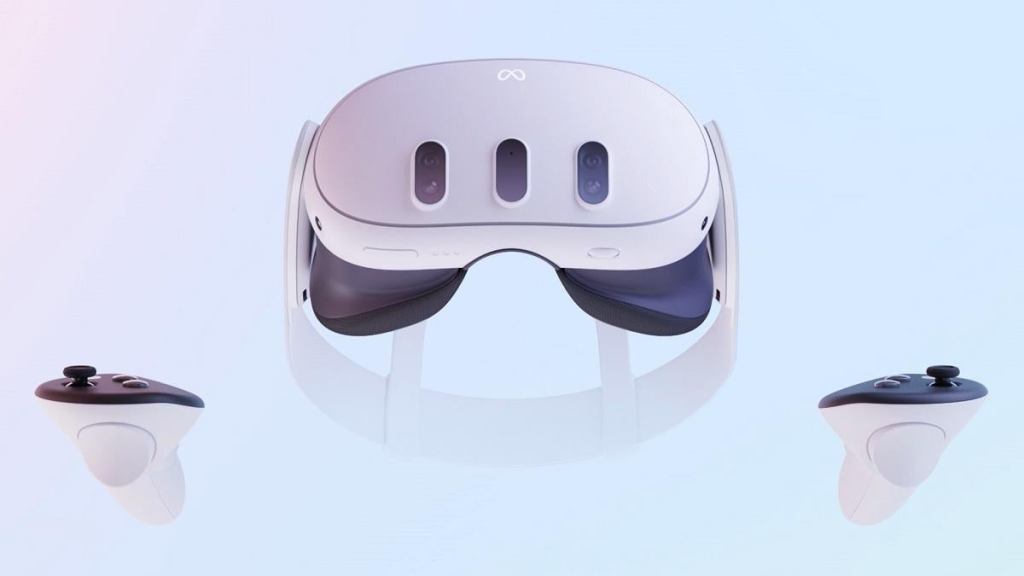As far as the more accessible Meta Quest devices go (or non-Meta virtual reality devices, for that matter), the Meta Quest 3 so far feels like the best way to sell someone on VR. It looks quite similar to the Meta Quest 2, and the under-the-hood upgrades may not mean much to someone who’s casually interested in getting started with virtual reality, but upgrades like the passthrough feature that’s better than ever and the potential it offers when it comes to mixed reality are exciting glimpses into what’s to come and what is, to an extent, already possible. The device itself and its capabilities are formidable, though it still feels as though the Meta Quest 3 is waiting on that one fitting game or experience to best capitalize on all of these possibilities.
Videos by ComicBook.com
While not wholly new to the Meta Quest 3 since its predecessor offered the same freedom, let’s start by praising the cord-free commitment of the new Meta Quest device. Its refined controllers may still be restrained to pesky disposable batteries, but the fact that the headset itself has managed to become even slimmer while not requiring someone to be physically plugged into a device is a defining characteristic of the headset when other VR devices like the PlayStation VR2 maintain these corded constraints.
On the topic of the redesigned controllers and the slimmer headset, those two changes are ones that’ll be immediately evident to those who’ve followed the Meta Quest family of peripherals through its various iterations but will still be noticeable to those who are just now embarking into VR. The difference in weight between the Meta Quest 2 and the Meta Quest 3 is mostly negligible, so we’re not at the point yet where this slimmer design will make you feel like you’re not even wearing a headset at all, but the slimmer design does make the device feel and look less intrusive overall. The same goes for the new controllers which ditch the O-shaped ring around the top and look much more like something you’d actually want to be seen using.
That goal of total immersion is helped, too, by the new head strap design that features more of a “Y” shape over the top of your head as opposed to one single strap. It allows for a more comfortable fit that makes the headset feel a bit more stable during more active VR sessions, though the juxtaposition of tugging on Velcro straps for such a boundary-pushing device is a funny one even if I have no idea what a better solution would be.
Form factor aside, the actual technological advancements the Meta Quest 3 boasts are headlined, by far, by the new and very improved passthrough feature. Gone is the grey muck from the Meta Quest 2’s passthrough feature where you can see your actual surroundings behind whatever virtual screen you’re looking at — the Meta Quest 3 features full-color passthrough. We can talk about being immersed in VR all day, but this mixed reality feature offers a different type of immersion, one that blends your virtual surroundings with your real-world environment. Having menus, videos, and more up on your wall while you walk around your home and control what’s in your visor either with the controllers themselves or with hand gestures is a giant leap forward for the Meta Quest devices. This was possible to an extent in the past, but it was impossible to achieve this level of immersion before when everything in your passthrough peripherals was either grey or blinding white prior to the Meta Quest 3.

But even with those upgrades, there’s still the logistics of actually using a Meta Quest 3 to be considered. Going cordless is a boon, but your play area, lighting, and tolerance of time spent in VR are all limiting factors on the headset. Passthrough can still be a bit fuzzy around the edges if conditions aren’t optimal, and whether due to space, people you live with, or other factors, optimal conditions simply aren’t always possible compared to something as easy as sitting down with a console or a PC. The Meta Quest 3 sports a battery life of approximately 2 hours give or take and depending on what you’re doing which thankfully feels like just the right amount of time spent in VR once you’ve got your settings in order so that you’re not having to spend half your time adjusting for comfort.
Given how niche VR still is today, the Meta Quest 3 partially has the luxury of being defined by its features alone rather than the library it sports, a library which, for now, mostly consists of VR games for past Meta Quest devices that are compatible with this one, too. That’s a boon for those who are upgrading rather than starting fresh, but it’s also a continuation of an issue past iterations grappled with. Aside from fully-fledged VR staples like Beat Saber and Blade & Sorcery as the latter continues to improve, the Meta Quest 3 lacks a defining app or experience that’d convince someone to invest. Asgard’s Wrath 2, an exclusive VR RPG coming to the Meta Quest 2 and Meta Quest 3 and one that’s free for early Meta Quest 3 adopters, is seemingly being positioned as that kind of game that’ll showcase the power of the VR devices. VR has long been regarded as a niche interest waiting on one or two must-have experiences, however, so the irony of the Meta Quest 3 being sold earlier than Asgard’s Wrath 2 with the latter a promise of what’s to come is a bit of irony not lost on me.
Compared to other VR devices, the Meta Quest 2 was already a clear winner at the intersection of comfort, price, and usability, and considering how the Meta Quest 3 expands on many of the Meta Quest 2’s features, it’s no wonder that the Meta Quest is once again positioned as a go-to VR device for newcomers and enthusiasts alike. But if you’re planning on picking one up, perhaps make sure that you’ve got a decent backlog in mind, and consider the logistics of your setup first.
The Meta Quest 3 is on sale now as a 128GB model for $499.99 and a 512GB model for $649.99. A review unit was provided by Meta.








